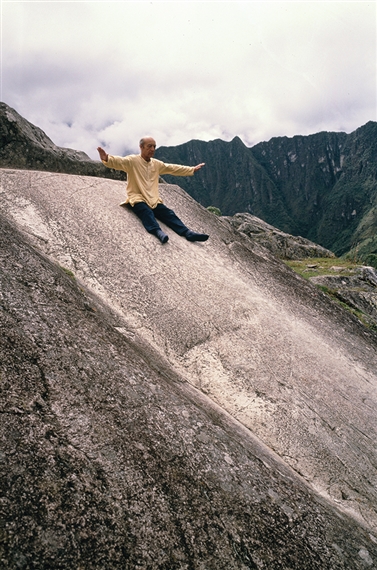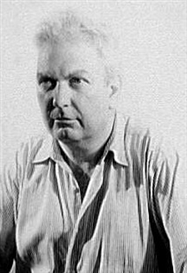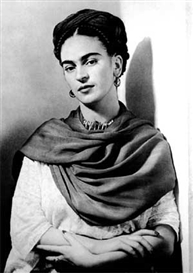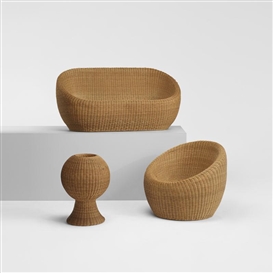Isamu Noguchi: The International Idealist of Modern Sculpture
If it were left up to Gutzon Borglum, the 20th century would have been deprived of one of its most original sculptors. Borglum had taken on an apprentice by the name Sam Gilmour in the summer of 1922, and apparently wasn鈥檛 very impressed. By summer鈥檚 end, he informed Sam that he would never become a sculptor. Borglum would go on to sculpt the monument Mount Rushmore, while Sam would go on to become one of the most important modern artists in history鈥擨samu Noguchi.
Natalie Hegert / 黑料不打烊
Dec 21, 2016

Isamu Noguchi at Machu Picchu, 1983. The Isamu Noguchi Foundation and Garden Museum, New York.
If it were left up to Gutzon Borglum, the 20th century would have been deprived of one of its most original sculptors. Borglum had taken on an apprentice by the name Sam Gilmour in the summer of 1922, and apparently wasn’t very impressed. By summer’s end, he informed Sam that he would never become a sculptor. Borglum would go on to sculpt the monument Mount Rushmore, while Sam, deflated, left for New York City, abandoned his dream of becoming an artist, and enrolled in medical school. Fortunately, his mother convinced him to take some art classes along with his medical training. Sam’s work was met with such enthusiasm by the head of the art school he attended, that he dropped out of med school, took on his father’s last name (he was the illegitimate child of Japanese poet Yone Noguchi and American writer Leonie Gilmour), and pursued sculpture full time. He would go on to become one of the most important modern artists in history—Isamu Noguchi.
Installation view - Isamu Noguchi, Age, 1981, in Isamu Noguchi, Archaic/Modern at Smithsonian American Art Museum. © The Isamu Noguchi Foundation and Garden Museum, New York.
Noguchi’s career as an artist, inventor, designer, and landscape architect spanned six decades, from the 1920s until his death in 1988. Born in Los Angeles, raised in Japan, Noguchi traveled extensively in his life—from New York, to Paris, to Beijing, to Mexico City—and kept company with artists from around the world, from a wide range of disciplines—from painters, to potters, to designers, to dancers. Isamu Noguchi, Archaic/Modern at the Smithsonian American Art Museum surveys the broad perspectives and multi-faceted interests of this international artist, through a collection of 74 of his works, including sculptures, as well as his work in stage sets, patented designs, and landscapes.
Isamu Noguchi, Red Lunar Fist, 1944, magnesite, plastic, resin and electric components, The Isamu Noguchi Foundation and Garden Museum, New York. Photo: Kevin Noble. © The Isamu Noguchi Foundation and Garden Museum, New York.
The Rolodex of associates and friends of Isamu Noguchi is astonishing for its breadth and caliber, providing a glimpse into the varied sources that influenced his work. While Gutzon Borglum may have been the first artist of repute that Noguchi encountered in his travels, luckily he was not the last. When Noguchi arrived in New York, after his fateful apprenticeship, he began frequenting the galleries showing avant-garde work from Europe—Alfred Stieglitz’s 291 Gallery and J. B. Neumann’s New Art Circle—where he would be introduced to the work of modern sculptors like Constantin Brancusi. In 1927, Noguchi received a Guggenheim fellowship that set him on the path of the global art traveller, going first to Paris, where he assisted with Brancusi, and met artists Jules Pascin and Alexander Calder. He returned to New York in 1929, where he was introduced to Buckminster Fuller and modern dance choreographer Martha Graham, two artists with whom he would collaborate. In 1930 he boarded the Trans-Siberian Railway and traveled across Asia, studying brush painting with Qi Baishi in Beijing, and pottery with Uno Jinmatsu in Kyoto. Through the 30s he worked on commissions of public art, creating a mural in Chicago with Santiago Martinez Delgado, and one in Mexico, where he met, and had an affair with, Frida Kahlo. The list goes on: Noguchi road tripped with his good friend Arshile Gorky; he designed furniture with Herman Miller (the iconic Noguchi table is still in production today); and designed sets for Martha Graham, John Cage and Merce Cunningham. Other artists with whom he crossed paths include architect Edward Durell Stone, choreographer George Balanchine, designer Isamu Kenmochi, architect Kenzo Tange, architect Gordon Bunshaft, potter Kitaoji Rosanjin, architect Marcel Breuer, architect Louis Isadore Kahn, and sculptor Masatoshi Izumi.
Isamu Noguchi, Sculpture Finding, 1979, basalt. The Isamu Noguchi Foundation and Garden Museum, New York. Photo: Shigeo Anzai. © The Isamu Noguchi Foundation and Garden Museum, New York.
Drawing from such inspirations as Stonehenge, the ancient temple complexes of Mexico, and Kofun burial mounds in Japan, Noguchi’s aesthetic looked toward an idealized primitive, while embracing a futuristic modernity. Seeing Brancusi’s abstract, elementary forms was a turning point for the formerly academic sculptor. “It became self-evident to me that in so-called abstraction lay the expression of the age and that I was especially fitted to be one of its prophets,” Noguchi said in 1929.
Martha Graham dons Noguchi’s Spider Dress while standing on his Serpent in the 1946 production, Cave of the Heart, Courtesy of the Library of Congress.
Noguchi’s vision of art and sculpture was expansive and unifying. He invested his energy into designing functional objects, social spaces, public art, landscape architecture, and theatrical sets as much as he did into fine art sculpture. In his mind, art should not be separated from daily life; modern sculpture should instead occupy the same functions as ritualistic objects and spaces of the ancient past, thereby infusing life with more meaning. His thoughts on stage set design illuminate this philosophy: “There is joy in seeing sculpture come to life on the stage in its own world of timeless time. Then the very air becomes charged with meaning and emotion, and form plays its integral part in the re-enactment of a ritual.” Martha Graham’s ritualistic, primordial ballets certainly embody this notion, and Noguchi’s theatrical sculptures—such as his Spider Dress and Serpent, for Graham’s 1946 ballet Cave of the Heart, which are on view at the Smithsonian—translated the symbolism of the dance into visual form. Noguchi said, “Theater is a ceremonial; the performance is a rite. Sculpture in daily life should or could be like this. In the meantime, the theater gives me its poetic, exalted equivalent.”
Isamu Noguchi, Grey Sun, 1967, Arni marble, Smithsonian American Art Museum, Gift of the artist. Photo: Gene Young. © The Isamu Noguchi Foundation and Garden Museum, New York.
Noguchi’s ideal of sculpture in daily life, it could be argued, was achieved in some measure in his designs for public spaces and landscape projects. His inhabitable sculptures, playgrounds, and public plazas appear around the world, from New York, to Jerusalem. These sites combine elements of playfulness with the meditative qualities of Zen gardens, in an effort to improve public life. It’s no wonder that Noguchi found kindred spirits in the likes of Buckminster Fuller and other designers and architects who were likewise driven to further humanity’s progress through modern design. The drawbacks of scientific advancement, however, were also evident to Noguchi, who witnessed, with a most personal devastation, the horror of the atomic bombs dropped on Japan during World War II. His sculptural forms of that time, all rocketship curves and sleek biomorphism, defined the aesthetic sensibility of the atomic era.
Isamu Noguchi, Trinity, 1945, fabricated 1988, bronze plate. The Isamu Noguchi Foundation and Garden Museum, New York. Photo: Kevin Noble. © The Isamu Noguchi Foundation and Garden Museum, New York.
Until his death, in 1988, Noguchi lived between the United States and Japan, and continued to travel extensively, especially to Italy, in his later years, for the quality of its stone. His multinational perspective made him ”among the first American artists to think like a citizen of the world,” said Betsy Broun, Director of the Smithsonian American Art Museum. One work that particularly captures this viewpoint was never realized, but speaks volumes to Noguchi’s philosophy of the world: Model for Sculpture to be Seen from Mars (1947), a proposed earthwork of a human face made of simplified geometric forms, a monument to a universal humanity.
Isamu Noguchi, Model for Sculpture to Be Seen from Mars, 1947 (no longer extant), sand. The Isamu Noguchi Foundation and Garden Museum, New York. Photo: Soichi Sunami, image courtesy the Isamu Noguchi Foundation and Garden Museum.
Isamu Noguchi, Archaic/Modern is on view at the Smithsonian American Art Museum from November 11 through March 19, 2017. A presentation of Cave of the Heart by the Martha Graham Dance Company will take place on March 3, 2017.
—Natalie Hegert






























